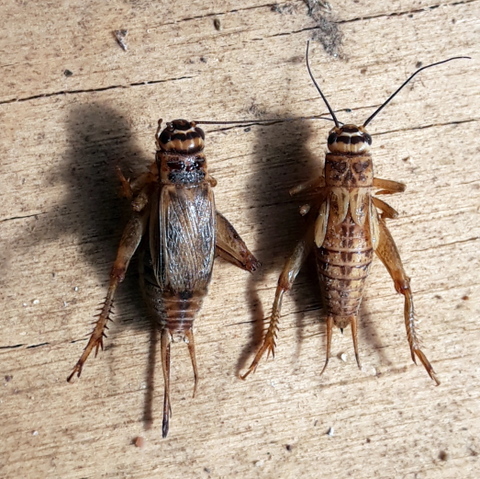Temperature Maintenance
I have read various ranges for the optimum temperature for raising crickets to be anywhere between 20⁰C and 35⁰C. We get temperatures here as high as 40⁰C+ in summer and down as low as a couple of degrees above freezing in winter. I have nursed crickets through our winter, keeping them inside, where temperatures got down to the low teens overnight without much problem, and this summer has been mild so they are doing OK with temps in the high 30s.
Having said all that, when I was reading up about crickets, I decided I did want some supplementary heating to help them along. Generally people tend to use a heat lamp or emitter to maintain the temperature, although heating pads are also used. I had a small (very small) heating pad I had bought in for something else, didn’t use it and it was still sitting in the box. Bear in mind that this was still when I had only my ‘seed’ cricket colony of only a couple dozen individuals.

The heating mat was designed to be used with hermit crabs (!) and the brand name is ‘Krabooz’. It can be stuck onto the side or base of the cricket house with built-in adhesive, but I did not use it like that, to facilitate cleaning. It does not give much of the way of information about specs, but it uses 2.5 watts at 230 Vac and physically it is 80mm x 130mm. I would leave it on 24hrs a day and it was very popular with the crickets, crawling on, over, under and generally all around it.
With the new, much larger colonies I may have to look at a larger pad or heat lamp to keep the colonies thriving and growing through winter.
Breeding
I am not going to go over the whole ‘birds and the bees’ talk but it goes without saying that if you want the pitter patter of little cricket feet, you will need both males and females, and that presupposes you can tell them apart. Fortunately it is quite easy – Male crickets have two small spikes protruding from either side of the rear of their abdomen, while females have a single ovipositor protruding directly from the rear of the abdomen. Presuming you have some of both it is just a case of letting them do their cricket thing.

Or so I thought!
They do need, food, water and warmth to be happy and breed, and I have also read that the males need to be of an age to be able to chirp or sing and if they are not making noise they will not mate. That does not seem to be the case from my experience. The females also need a medium to lay their eggs into, and I have seen a number of suggestions, and while garden soil makes eminent sense to me, I decided to use coarse sand, because that’s what I had.
So I placed damp sand into a 900ml polypropylene bowl used as a takeaway food container by the local noodle place (again, making use of what we had). Whatever you use in the way of containers needs to be at least 32mm deep, because the crickets burrow down 25mm or so to lay their eggs. In any case the bowls I was using were 75mm deep, so plenty deep enough.

I made sure the sand was damp, and kept it damp with a fine water spray while it was in use. I placed it in the cricket home, and from my observations the females started to use it right away. I left it in the habitat for about 3 weeks, because I had read it takes two weeks for the baby crickets (or pinheads) to start to hatch. After 3 weeks……nothing!
To make it easier to keep track of what was happening, at this point I transferred the sand filled bowl into another, pre-prepared tote and kept it moist for another two weeks. Still nothing. By this stage most of the laying adults had passed on, or become chook appetisers. I assumed that the original set of crickets were infertile for some reason, cleaned out the original cricket habitat and proceeded to ignore the nursery tote. I bought a new set of crickets and installed them in the refurbished cricket habitat, including the breeding bowl, to see what would happen, and sure enough the females started using it immediately. I must admit that I was confused.

Two weeks after the cricket changeover I was in the garage checking on things and decided it was time to remove and dispose of the original breeding bowl and clean out the nursery tote. When I went to clean it out I found, to my amazement, it was infested with ants! However on closer inspection I found they were actually pinheads! I had babies!

They had survived with no food or water for a week or two after hatching, depending on how long ago they hatched. I remedied that and placed some cricket food, the same wholemeal flour/powdered milk mix I was feeding the adults plus some citrus slices and lettuce leaves. They seem to do pretty well on that diet. The second set of crickets did the same thing and I now have two nursery totes, the crickets in the first one are now about fully grown and the crickets in the second one are not far behind.
The system works!!!!!



